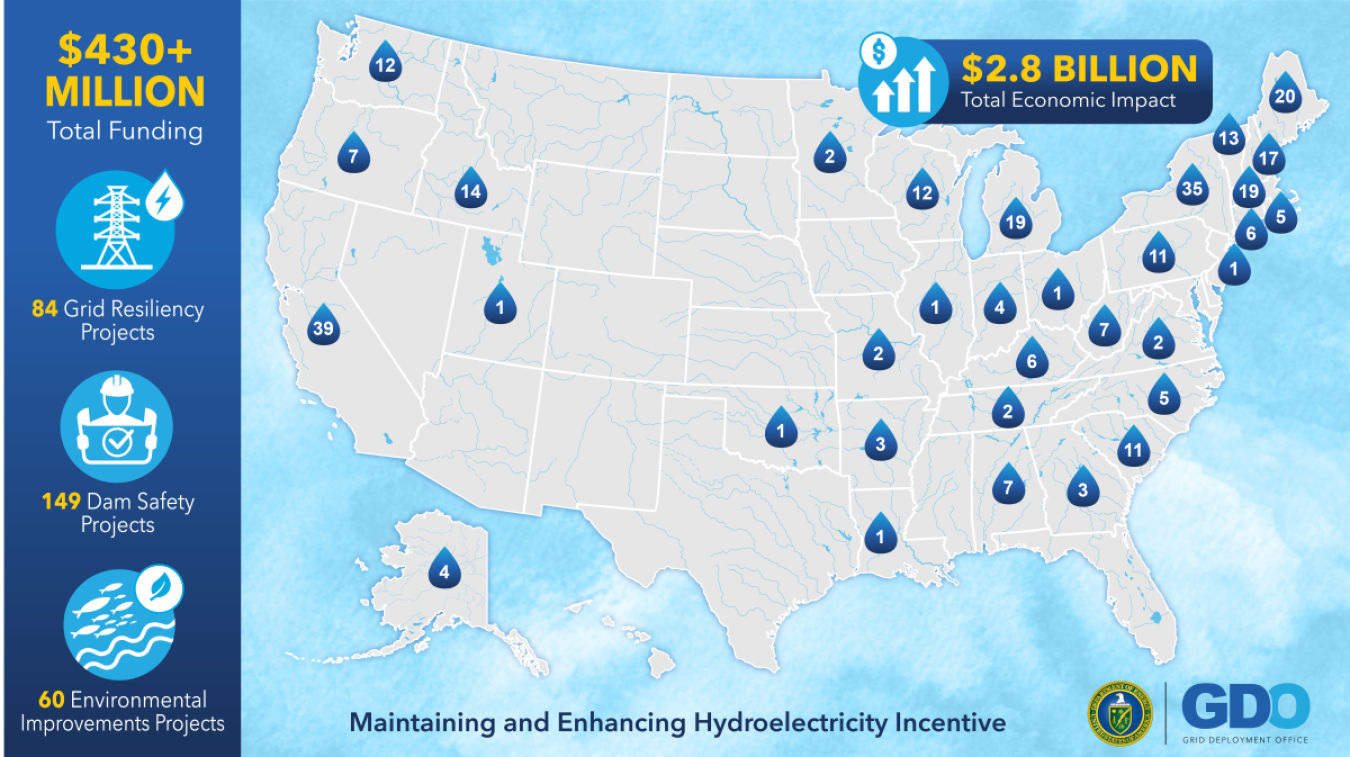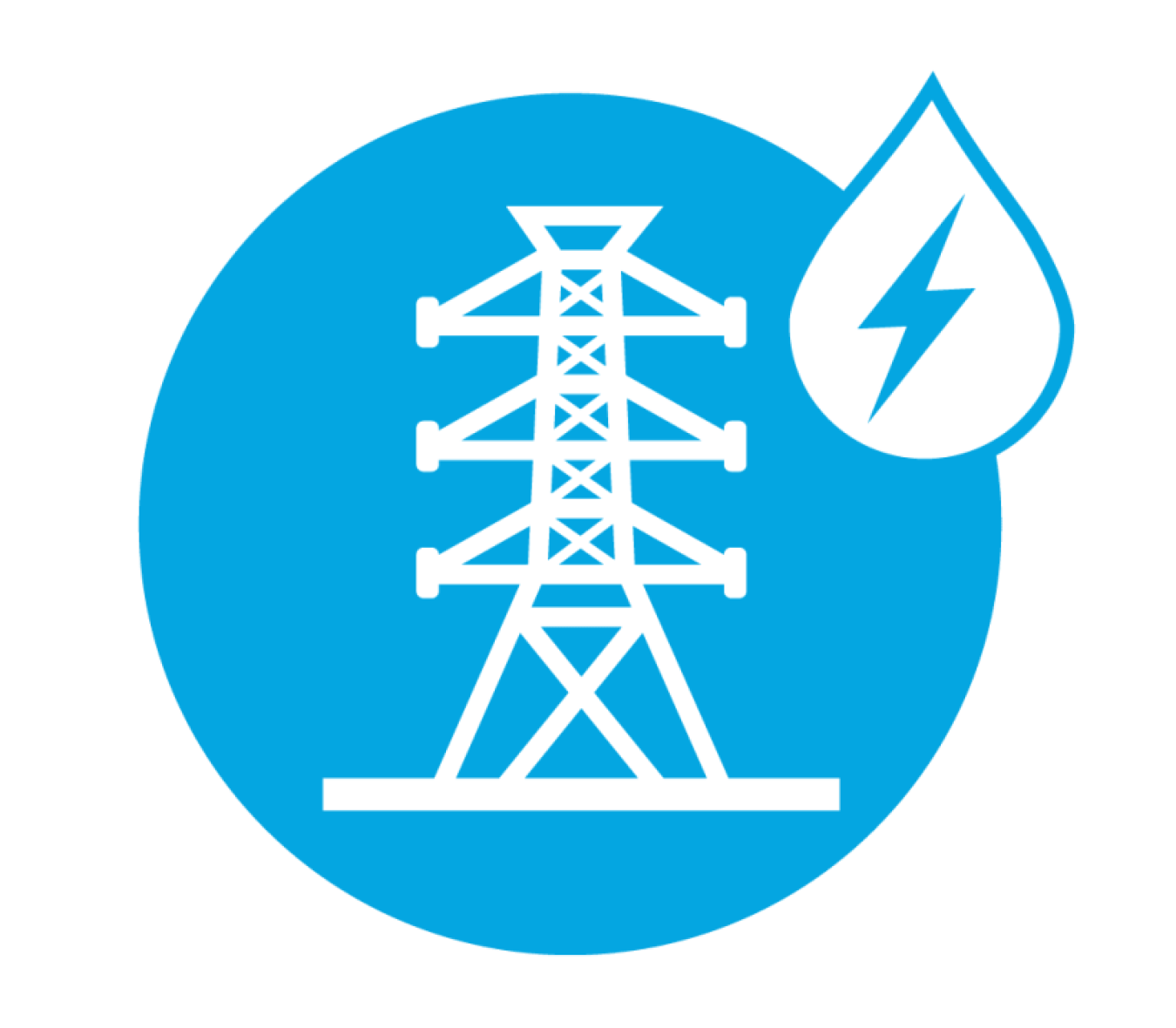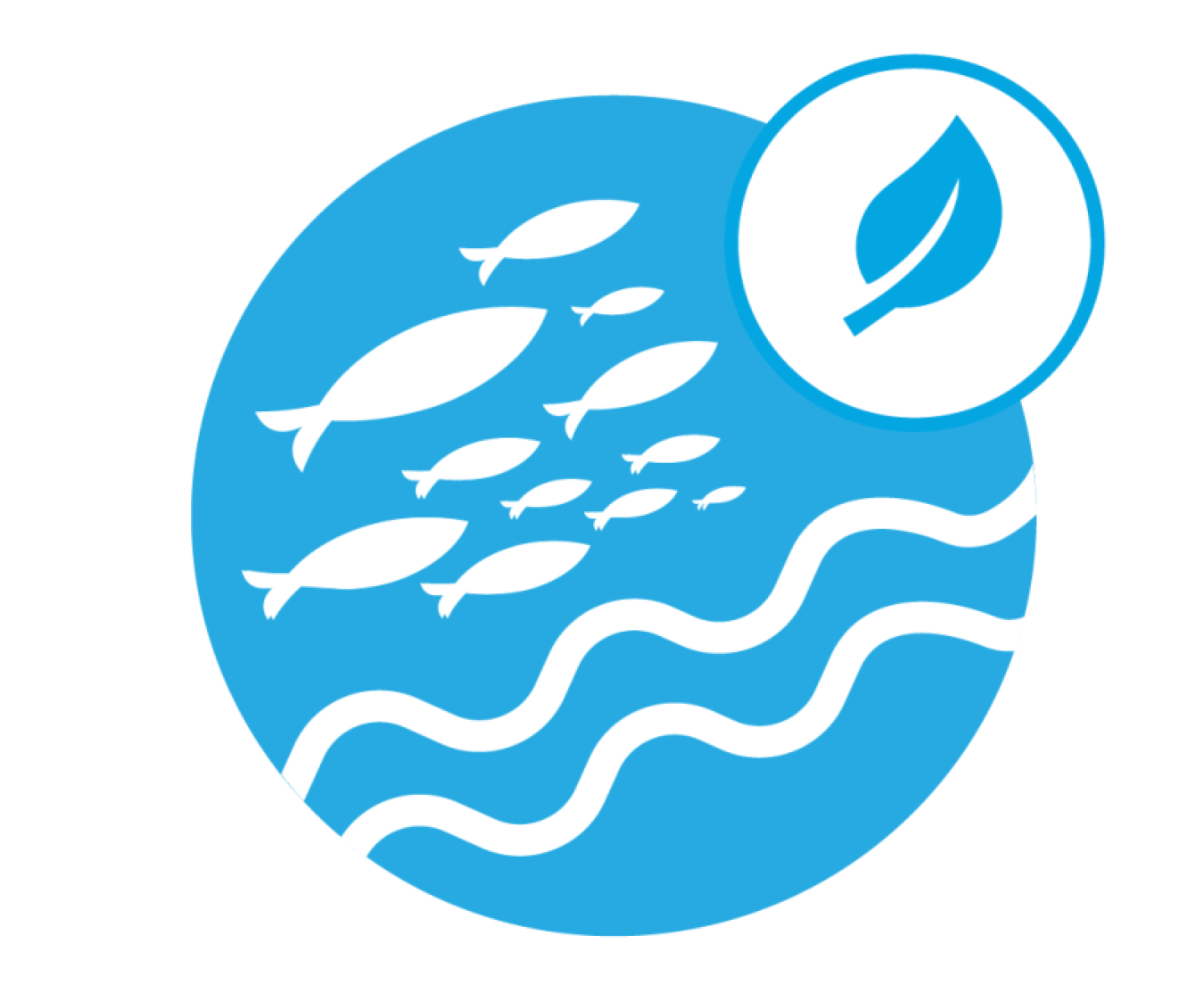On September 5, 2024, the Grid Deployment Office announced the selection of 293 capital improvement projects for negotiations across 33 states to receive over $430 million in Maintaining and Enhancing Hydroelectricity Incentive payments.

Note, per the statutory requirement, DOE will fund all qualified capital improvement projects at the limits set forth in Section 247 (30% of total project costs, not to exceed $5,000,000) within a qualified hydroelectric facility. In some cases, a qualified facility submitted multiple project applications, but the total incentive per facility cannot exceed $5,000,000. This accounts for the discrepancy between the funding totals sum and the actual aggregate award value.
- Projects: 39 in California
- Total incentive payments requested: $68.6M
- Capital Improvement Categories:
- Grid Resiliency: 5
- Dam Safety: 30
- Environmental Improvements: 4
The 39 projects in California will provide economic benefits including:
- Committing to hiring local workers or contractors
- Providing apprenticeship, pre-apprenticeship, and youth education programs to showcase the opportunities available in the clean energy workforce
- Over 30 contracts are already in place with, or commitments have been made to a contractor preference for, businesses majority owned or controlled by underrepresented persons or groups of underrepresented persons
- 100% of projects will directly benefit a Disadvantaged Community
- Projects: 47 throughout New Jersey, New York, Pennsylvania
- Total incentive payments requested: $50M
- Capital Improvement Categories:
- Grid Resiliency: 10
- Dam Safety: 16
- Environmental Improvements: 10
The 47 projects in the Mid-Atlantic Region will provide economic benefits including:
- Committing to hiring local workers or contractors
- Providing apprenticeship, pre-apprenticeship, and youth education programs to showcase the opportunities available in the clean energy workforce
- Nearly 26 contracts are already in place with, or commitments have been made to a contractor preference for, businesses majority owned or controlled by underrepresented persons or groups of underrepresented persons
- Nearly 75% of projects will directly benefit a Disadvantaged Community
- Projects: 42 throughout Illinois, Indiana, Michigan, Minnesota, Missouri, Ohio, Oklahoma, Wisconsin
- Total incentive payments requested: $63.5M
- Capital Improvement Categories:
- Grid Resiliency: 8
- Dam Safety: 33
- Environmental Improvements: 1
The 42 projects in the Midwest Region will provide economic benefits including:
- Committing to hiring local workers or contractors
- Providing apprenticeship, pre-apprenticeship, and youth education programs to showcase the opportunities available in the clean energy workforce
- Nearly 40 contracts are already in place with, or commitments have been made to a contractor preference for, businesses majority owned or controlled by underrepresented persons or groups of underrepresented persons
- Over 97% of projects will directly benefit a Disadvantaged Community
- Projects: 80 throughout Connecticut, Maine, Massachusetts, New Hampshire, Rhode Island, Vermont
- Total incentive payments requested: $65.5M
- Capital Improvement Categories:
- Grid Resiliency: 23
- Dam Safety: 32
- Environmental Improvements: 25
The 80 projects located in New England will provide economic benefits including:
- Committing to hiring local workers or contractors
- Providing apprenticeship, pre-apprenticeship, and youth education programs to showcase the opportunities available in the clean energy workforce
- Over 56 contracts are already in place with, or commitments have been made to a contractor preference for, businesses majority owned or controlled by underrepresented persons or groups of underrepresented persons
- Over 67% of projects will directly benefit a Disadvantaged Community
- Projects: 47 throughout Alabama, Arkansas, Georgia, Kentucky, Louisiana, North Carolina,
South Carolina, Tennessee,
Virginia, West Virginia - Total incentive payments requested: $83M
- Capital Improvement Categories:
- Grid Resiliency: 18
- Dam Safety: 21
- Environmental Improvements: 8
The 47 projects in the Southeast Region will provide economic benefits including:
- Committing to hiring local workers or contractors
- Providing apprenticeship, pre-apprenticeship, and youth education programs to showcase the opportunities available in the clean energy workforce
- Nearly 70 contracts are already in place with, or commitments have been made to a contractor preference for, businesses majority owned or controlled by underrepresented persons or groups of underrepresented persons
- Over 87% of projects will directly benefit a Disadvantaged Community
- Projects: 47 throughout Alabama, Arkansas, Georgia, Kentucky, Louisiana, North Carolina,
- Projects: 38 throughout Alaska, Idaho, Oregon, Utah, Washington
- Total incentive payments requested: $99.5M
- Capital Improvement Categories:
- Grid Resiliency: 18
- Dam Safety: 12
- Environmental Improvements: 8
The 38 projects in the Western Region will provide economic benefits including:
- Committing to hiring local workers or contractors
- Providing apprenticeship, pre-apprenticeship programs, and youth education to showcase the opportunities available in the clean energy workforce
- Nearly 50 contracts are already in place with, or commitments have been made to a contractor preference for, businesses majority owned or controlled by underrepresented persons or groups of underrepresented persons
- Over 92% of projects will directly benefit a Disadvantaged Community

Projects
Search Tip: If you are looking for projects within a specific state, type the full name of the state in the search bar.


Grid Resiliency
- Adapting more quickly to changing grid conditions
- Providing ancillary services, such as black start capabilities or voltage support
- Integrating other variable sources of electricity generation
- Managing accumulated reservoir sediments, which removes sediment and debris from the reservoir floor to allow for an increase in reservoir storage capacity

Dam Safety
- Maintenance/upgrade of spillways or other structures related to the safety of a dam
- Dam stability improvements, including erosion repair and enhanced seepage controls
- Upgrades/replacements of floodgates or natural infrastructure restoration

Environmental Improvements
- Adding or improving existing fish passage
- Improving water quality
- Promoting downstream sediment transport processes and habitat maintenance to protect the surrounding area and migration of aquatic species
- Improving recreational access
Grid Resiliency
Jeff L. Taylor – Pine Flat Hydroelectric Project, Kings River Conservation District, Piedra, California ($5M requested) will add a new small hydroelectric unit to the existing plant that can be brought up to full speed within a minute and made available for synchronizing to the grid, as well as ramped up to full capacity within a couple minutes. This will result in increased energy to the grid and also supports grid frequency and voltage in times when the other renewable resources are not available or when the grid needs a quick boost. The facility is located on the Kings River and began operations in 1984.
Vischer Ferry Hydroelectric Project, New York Power Authority, Rexford, New York ($2.5M requested) will perform a life extension and modernization project to include rehabilitation to mechanical and electrical systems and modifications for a possible future turbine replacement. The facility is currently considering installation of a turbine technology to replace an aging turbine. The facility is located on the Mohawk River and began operations in 1920.
Greenup Hydroelectric Project, City of Hamilton Ohio & American Municipal Power, Inc., Franklin Furnace, Ohio ($976K requested) will modernize control systems, replace cabling, and install a new transformer resulting in increased plant reliability and overall efficiency. The facility is located on the Ohio River and began operations in 1982.
Housatonic River Project, FirstLight CT Housatonic LLC, Southbury, Connecticut ($3.6M requested) will conduct a turbine runner replacement to increase efficiency, power, and operating range. A controls and excitation upgrade will increase grid reliability through advanced controls and improved ramp rates. The project will also include the replacement of a transformer with the goal of increasing grid reliability. This facility is Connecticut’s largest hydroelectric generation station and is also the second largest source of carbon-free electricity in the state. The facility is located on the Housatonic River in Connecticut and began operations in 1919.
Smoky Mountain Hydroelectric Project, Brookfield Renewable, Robbinsville, North Carolina, ($1.5M requested) will make grid resilience upgrades that will provide faster and more reliable response to rapidly changing grid conditions and increase overall grid resiliency. Much of the equipment in the plant is original. The facility impounds Lake Santeetlah and began operations in 1928.
Salmon Creek Hydroelectric Project, Alaska Electric Light and Power Company, Juneau, Alaska ($5M requested) will replace a portion of the original penstock with a modern welded penstock. This replacement will reduce penstock losses, thereby increasing system efficiency and the amount of power that can be produced by the turbines. The project will provide reliable hydroelectricity to Juneau, and it will provide water to both the City and Borough of Juneau municipal water utility and a private fish hatchery. This facility is located on Salmon Creek in Juneau and began operations in 1914.
Dam Safety
Scotts Flat Spillway, Nevada Irrigation District, Grass Valley, California ($5M requested) will rebuild and reshape the spillway to address water flow capacity and erosion issues. The dam was originally constructed in 1949, subsequently raised by 35 feet in 1964, and began generating power in 1985. It is located on the Deer Creek River and is a multi-use facility providing domestic and agricultural water needs, as well as recreation and power generation.
Oswego High Dam Hydroelectric Station, City of Oswego, Oswego, New York ($400K requested) will conduct structural dam safety upgrades to the spillway toe scour and structural inspections of the spillway surface to locate toe scours, pockets or voids that naturally form under a dam and need to be periodically filled. The facility is located on the Oswego River and began operations in 1929.
Kaukauna City Plant Hydroelectric Project, Kaukauna Utilities, Kaukauna, Wisconsin ($117K requested) will complete concrete and other repairs to the left tailrace and forebay walls to prevent seepage and ensure the stability of the dam. The facility is located on the Lower Fox River and began operations in 1941.
Five Channels Dam, Consumers Energy, Oscoda, Michigan ($1.4M requested) will retire and fill in a bay where a turbine was never installed and replace gates and a training wall that has deteriorated. This project will increase safety for the facility's personnel as well as the overall safety of the dam. The facility is located on the Au Sable River and began operations in 1912.
Clyde River Hydropower, Great Bay Hydro Corporation, Newport, Vermont ($1.1M requested) will conduct a water conveyance repair and improvement, as well as upgrade a surge tank which will increase the safety of these water carrying structures. Additionally, this project will include grid resiliency improvements such as upgrading the generating units to increase reliability and efficiency of power production. An environmental component has also been added to provide improvements to fish passage. The facility is located on the Clyde River of northern Vermont and began operations in 1936.
Buzzards Roost Hydroelectric Facility, Greenwood County, Chappells, South Carolina ($5M requested) will redesign and construct an emergency spillway channel and structure to prevent spilling of water over the top of the dam and continued water supply to two counties in the event of major flooding. The facility is located at the outfall of Lake Greenwood and began operations in 1939.
Carmen-Smith Hydropower Project, Eugene Water & Electric Board, McKenzie Bridge, Oregon ($5M requested) will design and build an auxiliary spillway to increase capacity and prevent overtopping of the dam in the event of prolonged flooding. The spillway expansion will serve a dual role in water management during high precipitation and snow melt events, while also providing an expanded habitat for the endangered Chinook Salmon and Bull Trout. The facility is located on the upper McKenzie River and began operations in 1963.
Environmental Improvements
Feather River Salmonid Habitat, California State Depart of Water Resources, Oroville, California ($832K requested) will enhance the Feather River’s salmonid spawning habitat by increasing the amount of clean spawning gravel at multiple existing spawning sites. This will provide benefits to Central Valley Spring-run Chinook Salmon, Central Valley Fall-run Chinook Salmon, and Central Valley Steelhead. This project is located on the Feather River, below Oroville Dam, which began operations in 1968.
York Haven, York Haven Power Company, LLC, York Haven, Pennsylvania ($5M requested) is constructing a fabricated natural fishway to provide upstream fish passage for American shad during their annual spring spawning migration, as well as river herring and American eel during their spring upstream migrations. The improvements will also establish connectivity of the entire aquatic community above and below the facility. The project is located on the Susquehanna River and began operations in 1904.
Penacook Lower Falls, Briar Hydro Associates, Boscawen, New Hampshire ($905K requested) will replace the existing trash rack with a new trash rack structure to improve downstream fish passage for eels. The facility is located on the Contoocook River in the Village of Penacook and began operations in 1983.
Dearborn Dam, Duke Energy Carolinas, LLC, Great Falls, South Carolina ($5M requested) conducted a major habitat and recreational water flow project on two natural whitewater river channels, the Long Bypass Reach and the Short Bypass Reach along the Great Falls Reservoir. The project resulted in the creation of whitewater river channels, the enhancement of natural habitats, construction of a large access area, and restoration of a historic building. The facility is located on the Catawba River and began operations in 1923.
T.W. Sullivan Hydroelectric Dam, Portland General Electric, Oregon ($782K requested) will replace three rubber dams, which are currently water flow control structures, to enhance the passage of juvenile fish near the facility. The project is located on the West Linn side of the Willamette River and was constructed in 1895, making it Oregon’s oldest hydroelectric plant in current operation and the third oldest in the United States.

